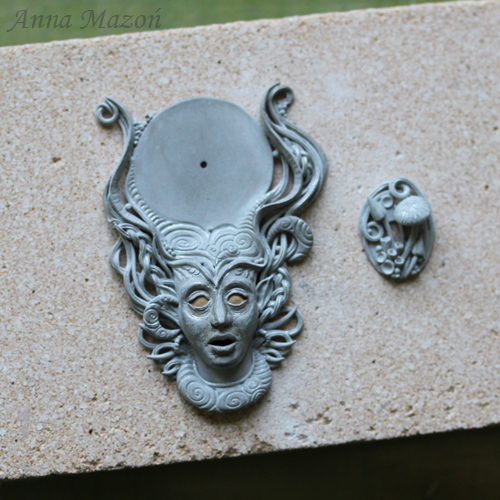
Sooo... Once upon a time ;-) I sculpted this tiny sun, using fine silver clay. I fired it, and left it for later. I even made a mould of it, which I rarely do, and added bronze versions to a few pieces, but the original little sculpture still wasn't used.
Finally I chose a stone and made a rough sketch of a general idea, slightly inspired by Art Deco (As if you could see anything in this sketch ;-)).
I didn't want to do anything too complicated.

Then I made more detailed templates, and glued them on a piece of sterling silver sheet. Note to self - really, really, you should buy a printer and start using vector art programs again (or a protractor, compasses, ruler etc. YAY! I loved geometric contructions at school ^^). Sketching freehand, in case of something that is not "organic" or super "flowy"doesn't lead to anything good. All the irregularities and inaccuracy started here. If you don't have a precise template for sawing, your sawing won't be precise. Yup, learning on mistakes again.
Anyway - I used what I sketched, marked places where I wanted to drill holes with a center punch and drilled them.
And here are my two elements after sawing and some cleaning. It's the first time I tried to saw elements that weren't "organic", but a little bit more geometrical and I have to say that it's so much more difficult than sawing swirls, waves , leaves and other pretty things ;-) (you can see under the links some examples of my other sawing attempts).
Then I started building the boxes. I measured circumference of the round element and cut a strip of sheet to form a circle that had a diameter and height I needed (more or less... next time I will REALLY measure things). I soldered two ends of the circle together, and then soldered it onto my round element. I also cut two more strips to form a crescent-like shape - the walls of the other element.
You can see in the photo that the strips are of different width. If I used a proper tool to make sure that they are equally wide I would definitely save some time... ;-) But, yeah, no... Learning. I am just too impatient and excited when I try something new. I just cut them freehand.
I formed a crescent shape out of the strips (it was quite difficult to get the same curve - I just used my hands and forming pliers - maybe there is an easier way... Again - coming back to the beginning - if my crescent shape was really made of two nice archs, I could simply use ring mandrel to get the right curve on the strips...). Then I filed the ends of the strips (I needed the places where they met, to be pointy, so they weren't visible from under the open work crescent shape), soldered them together and then soldered them onto the shape itself. I also found somewhere (you never know what you can find in your workshop one day ;-) ) twisted, decorative wire, and decided that this might be a nice touch to the whole look of my pendant, so I added it to both elements.
In case you're wondering why silver is so clean - I just took all the photos after pickling - otherwise everyhing would be covered with a ton of flux residue.
Now my boxes needed bottoms, and my stone needed a bezel cup. I formed a bezel, soldered it onto a piece of sheet, and cut out the inside. The stone has a nice back, so I wanted to show it, but my cunning plan ;-) was also to use this piece of sheet from the inside, for the bottom of the round element. Of course, because I judged it by eye, it turned out to be too small, so I had to find another piece of sterling to cut out the circle... Seriously... (facepalm ;-) ) Measure, measure! It's not metal clay where I can take a little bit more and roll it out again.
Before the last soldering I also filed/drilled a few holes in the walls, to make it possible to join the two parts of the pendant and to be able to string it somehow later. Then with an easy solder I soldered the crescent shape on top of the part with the bezel cup. In case of the round part, first I applied some solder on the back of my metal clay sun, flattened it on sanding paper, placed it in the right position, and then at the same time I soldered the round shape onto the circle and sweat soldered the sun on top of the box.
When I made sure that everything is really soldered I cut/file off spare silver from the edges and made sure they looked seamless.
I set the stone, made some finishing, and it was ready :-). You can see the back in the other photo below. I have to say that making this piece was a great lesson.... of cursing in all languages I know :-D. Just joking (yeah ;-) ).
























































